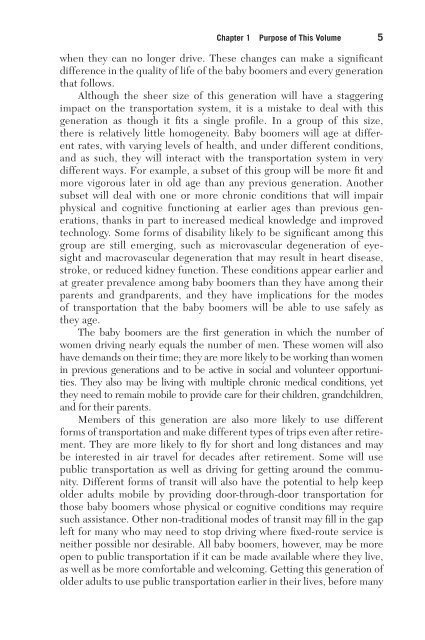Personal Choices and Public Policy - Springer Publishing
Personal Choices and Public Policy - Springer Publishing
Personal Choices and Public Policy - Springer Publishing
Create successful ePaper yourself
Turn your PDF publications into a flip-book with our unique Google optimized e-Paper software.
Chapter 1 Purpose of This Volume 5<br />
when they can no longer drive. These changes can make a significant<br />
difference in the quality of life of the baby boomers <strong>and</strong> every generation<br />
that follows.<br />
Although the sheer size of this generation will have a staggering<br />
impact on the transportation system, it is a mistake to deal with this<br />
generation as though it fits a single profile. In a group of this size,<br />
there is relatively little homogeneity. Baby boomers will age at different<br />
rates, with varying levels of health, <strong>and</strong> under different conditions,<br />
<strong>and</strong> as such, they will interact with the transportation system in very<br />
different ways. For example, a subset of this group will be more fit <strong>and</strong><br />
more vigorous later in old age than any previous generation. Another<br />
subset will deal with one or more chronic conditions that will impair<br />
physical <strong>and</strong> cognitive functioning at earlier ages than previous generations,<br />
thanks in part to increased medical knowledge <strong>and</strong> improved<br />
technology. Some forms of disability likely to be significant among this<br />
group are still emerging, such as microvascular degeneration of eyesight<br />
<strong>and</strong> macrovascular degeneration that may result in heart disease,<br />
stroke, or reduced kidney function. These conditions appear earlier <strong>and</strong><br />
at greater prevalence among baby boomers than they have among their<br />
parents <strong>and</strong> gr<strong>and</strong>parents, <strong>and</strong> they have implications for the modes<br />
of transportation that the baby boomers will be able to use safely as<br />
they age.<br />
The baby boomers are the first generation in which the number of<br />
women driving nearly equals the number of men. These women will also<br />
have dem<strong>and</strong>s on their time; they are more likely to be working than women<br />
in previous generations <strong>and</strong> to be active in social <strong>and</strong> volunteer opportunities.<br />
They also may be living with multiple chronic medical conditions, yet<br />
they need to remain mobile to provide care for their children, gr<strong>and</strong>children,<br />
<strong>and</strong> for their parents.<br />
Members of this generation are also more likely to use different<br />
forms of transportation <strong>and</strong> make different types of trips even after retirement.<br />
They are more likely to fly for short <strong>and</strong> long distances <strong>and</strong> may<br />
be interested in air travel for decades after retirement. Some will use<br />
public transportation as well as driving for getting around the community.<br />
Different forms of transit will also have the potential to help keep<br />
older adults mobile by providing door-through-door transportation for<br />
those baby boomers whose physical or cognitive conditions may require<br />
such assistance. Other non-traditional modes of transit may fill in the gap<br />
left for many who may need to stop driving where fixed-route service is<br />
neither possible nor desirable. All baby boomers, however, may be more<br />
open to public transportation if it can be made available where they live,<br />
as well as be more comfortable <strong>and</strong> welcoming. Getting this generation of<br />
older adults to use public transportation earlier in their lives, before many
















